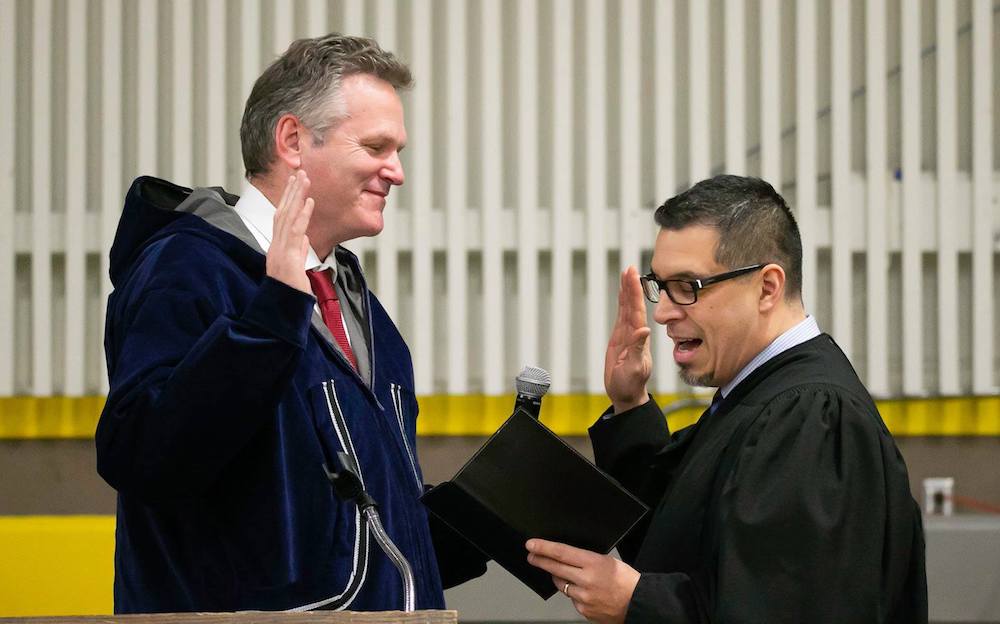How Alaska politics created the crisis threatening the state’s university system
Mike Dunleavy won the governor's race on a promise of higher Permanent Fund dividends without painful cuts. Then oil prices dropped.

The University of Alaska Board of Regents is expected to declare a financial emergency this week, beginning the process of major program cutbacks and layoffs statewide.
People across Alaska are in disbelief, thoroughly confused about how one of the richest states in the nation could potentially cripple a university that is a world leader in Arctic research.
A 41 percent cut in state funding would have a devastating impact on every aspect of the university, leading to the loss of up to 2,000 positions in the short run. More than 2,000 additional jobs would be lost because of the cuts in other parts of state government.
“While the short term losses represented a considerable shock to the economy, the consequences of these cuts on long term development could be even more pronounced,” said economists Mouhcine Guettabi and Nolan Klouda of the University of Alaska Anchorage.
It is not clear if the reductions can be reversed in the next few weeks, so the university is planning for the worst.
“Every day that passes without resolution means deeper cuts later this year, not to mention reduced enrollment and flight of faculty and staff,” University of Alaska President Jim Johnsen said Wednesday.
Alaskans find themselves in this position because as a candidate for Alaska governor in 2018, Mike Dunleavy made promises that he could not keep.
He promised that budget cuts would be painless, that the state could continue to avoid new taxes, such as personal income or sale taxes, and that he would see to it that Alaskans received larger Permanent Fund dividends.
After his election, oil prices slipped, destroying the Dunleavy fiscal fantasy. To preserve the idea of larger dividend checks, while avoiding new taxes, he called for the biggest cuts in state services in Alaska’s history.
He wants to distribute checks totaling about $2 billion to Alaskans, which is about $1 billion more than the state can afford.
At the lower level, which the state can afford, the payment would be roughly $1,500 per person.
Now, as the Legislature spends another summer trying to complete action on the budget for the fiscal year that began July 1, some of the fallout is beginning to hit home.
It will be many years before the full consequences are realized, but there will be immediate layoffs and reductions statewide at the university if there is no resolution within the next few weeks.
Dunleavy rejected a legislative budget compromise and vetoed $444 million from a variety of programs, with the university taking nearly one-third of that hit.
The Legislature spent three months creating a compromise budget that preserved the university and essential state services, but Dunleavy has made the size of the annual check his only budget priority.
Dunleavy faced heavy opposition from across the state by those who support the University of Alaska and want it to succeed. So far, that hasn’t made a difference.
“I believe that they can turn the university into a smaller, leaner, but still very, very positive, productive university here in the Northern Hemisphere,” Dunleavy said, though he has refused to offer any details.
A majority of the Alaska Legislature rejected his idea last week and voted to override the Dunleavy veto for the university and other programs — but that still fell short of the three-quarters vote required by the Alaska Constitution to sustain an override.
If the cuts go through, the university will need to raise tuition, but with higher tuition and fewer academic programs, enrollment is expected to decline.
There will also be a decline in research funding and research faculty.
Alaska’s university may lose its accreditation with cuts that could lead to wiping out nearly half of the Fairbanks and Anchorage campus operations.
The momentum of decline created by Dunleavy would damage the economy at a time when the state needs what the university can provide — graduates who can help create a stronger future for Alaska and have the training to take advantage of whatever opportunities arise.
The university has earned its reputation as a leading Arctic research center over many decades. It is a leader in climate change research, much of it carried out by scientists who are likely to move elsewhere, taking their federal grants with them.
Before the final vote, Johnsen, the University of Alaska president, said the veto “will strike an institutional and reputational blow from which we may likely never recover.”
He’s right about that. It remains to be seen if the Legislature can put together another solution and reject the governor’s unprecedented attack on higher education.
Dermot Cole can be reached at [email protected].